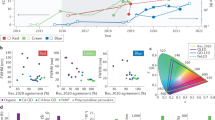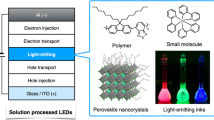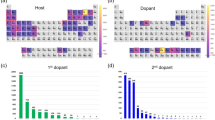Abstract
Inorganic phosphors have been crucial in enabling energy-efficient, phosphor-converted light-emitting diode (LED) lighting and display technologies. The push to increase the luminous efficacy and improve the colour quality of these lights has led to a surge in reports of different combinations of phosphor host structures and activators, with many claiming that the new materials have transformative properties. This Perspective article outlines the optical property requirements phosphors must meet to impact the field. Additionally, the tools that have been developed to accelerate the discovery of exceptional phosphors that meet these requirements are summarized, including crystal–chemical design rules, proxies, data-driven approaches, first-principles calculations and combinatorial methods. We also highlight open challenges in the field of phosphor discovery. Finally, we discuss the reality that these methods are unlikely to identify a perfect phosphor that satisfies all the requirements. Instead, we propose a workflow for phosphor discovery that prioritizes the properties necessary to produce next-generation phosphor materials.
This is a preview of subscription content, access via your institution
Access options
Access Nature and 54 other Nature Portfolio journals
Get Nature+, our best-value online-access subscription
$29.99 / 30 days
cancel any time
Subscribe to this journal
Receive 12 digital issues and online access to articles
$119.00 per year
only $9.92 per issue
Buy this article
- Purchase on Springer Link
- Instant access to full article PDF
Prices may be subject to local taxes which are calculated during checkout







Similar content being viewed by others
References
United Nations Environment Programme. The Rapid Transition to Energy Efficient Lighting: An Integrated Policy Approach. UNEP https://wedocs.unep.org/20.500.11822/8468 (2013).
Pust, P., Schmidt, P. J. & Schnick, W. A revolution in lighting. Nat. Mater. 14, 454–458 (2015).
George, N. C., Denault, K. A. & Seshadri, R. Phosphors for solid-state white lighting. Annu. Rev. Mater. Res. 43, 481–501 (2013).
Morgan, P. et al. 2022 Solid-State Lighting R&D Opportunities. US Department of Energy Office of Scientific and Technical Information https://doi.org/10.2172/1862626 (2022).
McKittrick, J. & Shea-Rohwer, L. E. Review: down conversion materials for solid-state lighting. J. Am. Ceram. Soc. 97, 1327–1352 (2014).
Meyer, J. & Tappe, F. Photoluminescent materials for solid-state lighting: state of the art and future challenges. Adv. Opt. Mater. 3, 424–430 (2015).
Luo, X. & Xie, R.-J. Recent progress on discovery of novel phosphors for solid state lighting. J. Rare Earths 38, 464–473 (2020).
Zhuo, Y. & Brgoch, J. Opportunities for next-generation luminescent materials through artificial intelligence. J. Phys. Chem. Lett. 12, 764–772 (2021).
Hariyani, S. & Brgoch, J. Spectral design of phosphor-converted LED lighting guided by color theory. lnorg. Chem. 61, 4205–4218 (2022).
Hariyani, S. & Brgoch, J. Advancing human-centric LED lighting using Na2MgPO4F:Eu2+. ACS Appl. Mater. Interfaces 13, 16669–16676 (2021).
Lumileds. Narrow Red Phosphor Technology. Lumileds https://lumileds.com/wp-content/uploads/files/WP32.pdf (2016).
Ohno, Y. Color rendering and luminous efficacy of white LED spectra. Proc. SPIE Int. Soc. Opt. Eng. 5530, 88–98 (2004).
National Research Council, Division on Engineering and Physical Sciences, Board on Energy and Environmental Systems & Committee on Assessment of Solid-state Lighting. Assessment of Advanced Solid-State Lighting (The National Academies Press, 2013).
Murphy, J. E., Garcia-Santamaria, F., Setlur, A. A. & Sista, S. 62.4: PFS, K2SiF6:Mn4+: the red-line emitting LED phosphor behind GE’s TriGain Technology™ platform. SID Int. Symp. Dig. Tec. 46, 927–930 (2015).
MacAdam, D. L. Specification of small chromaticity differences. J. Opt. Soc. Am. 33, 18–26 (1943).
Dorenbos, P. Crystal field splitting of lanthanide 4fn−15d-levels in inorganic compounds. J. Alloy. Compd. 341, 156–159 (2002).
Xia, Y. et al. Crystal structure evolution and luminescence properties of color tunable solid solution phosphors Ca2+xLa8−x(SiO4)6−x(PO4)xO2:Eu2+. Dalton Trans. 45, 1007–1015 (2016).
Jiang, L. et al. Multiobjective machine learning-assisted discovery of a novel cyan–green garnet: Ce phosphors with excellent thermal stability. ACS Appl. Mater. Interfaces 14, 15426–15436 (2022).
Lai, S., Zhao, M., Qiao, J., Molokeev, M. S. & Xia, Z. Data-driven photoluminescence tuning in Eu2+-doped phosphors. J. Phys. Chem. Lett. 11, 5680–5685 (2020).
van Uitert, L. G. An empirical relation fitting the position in energy of the lower d-band edge for Eu2+ or Ce3+ in various compounds. J. Lumin. 29, 1–9 (1984).
Park, W. B., Singh, S. P., Kim, M. & Sohn, K.-S. Phosphor informatics based on confirmatory factor analysis. ACS Comb. Sci. 17, 317–325 (2015).
Wang, Q. et al. Crystal structure and photoluminescence properties of Eu2+-activated Ba2LiB5O10 phosphors. Opt. Commun. 284, 5315–5318 (2011).
Sonekar, R., Omanwar, S. & Moharil, S. Combustion synthesis and photoluminescence of Eu2+ doped BaB8O13. Indian J. Pure Appl. Phys. 47, 441–443 (2009).
Lee, J.-W. et al. Metaheuristics-assisted combinatorial screening of Eu2+-doped Ca–Sr–Ba–Li–Mg–Al–Si–Ge–N compositional space in search of a narrow-band green emitting phosphor and density functional theory calculations. lnorg. Chem. 56, 9814–9824 (2017).
Park, W. B., Singh, S. P. & Sohn, K.-S. Discovery of a phosphor for light emitting diode applications and its structural determination, Ba(Si,Al)5(O,N)8:Eu2+. J. Am. Chem. Soc. 136, 2363–2373 (2014).
Strobel, P. et al. Narrow-band green emitting nitridolithoalumosilicate Ba[Li2(Al2Si2)N6]:Eu2+ with framework topology whj for LED/LCD-backlighting applications. Chem. Mater. 27, 6109–6115 (2015).
Park, W. B., Singh, S. P., Yoon, C. & Sohn, K.-S. Combinatorial chemistry of oxynitride phosphors and discovery of a novel phosphor for use in light emitting diodes, Ca1.5Ba0.5Si5N6O3:Eu2+. J. Mater. Chem. C 1, 1832–1839 (2013).
Park, W. B., Shin, N., Hong, K.-P., Pyo, M. & Sohn, K.-S. A new paradigm for materials discovery: heuristics-assisted combinatorial chemistry involving parameterization of material novelty. Adv. Funct. Mater. 22, 2258–2266 (2012).
Kulshreshtha, C., Sharma, A. K. & Sohn, K.-S. Search for new red phosphors using genetic algorithm-assisted combinatorial chemistry. J. Comb. Chem. 10, 421–425 (2008).
Singh, S. P., Kim, M., Park, W. B., Lee, J.-W. & Sohn, K.-S. Discovery of a red-emitting Li3RbGe8O18:Mn4+ phosphor in the alkali-germanate system: structural determination and electronic calculations. lnorg. Chem. 55, 10310–10319 (2016).
Takeda, T., Hirosaki, N., Funahashi, S. & Xie, R.-J. New phosphor discovery by the single particle diagnosis approach. Mater. Discov. 1, 29–37 (2015).
Zhang, Y. et al. Realizing red/orange emission of Eu2+/Ce3+ in La26−xSrxSi41Ox+1N80−x (x = 12.72–12.90) phosphors for high color rendition white LEDs. J. Mater. Chem. C 8, 13458–13466 (2020).
Hirosaki, N., Takeda, T., Funahashi, S. & Xie, R.-J. Discovery of new nitridosilicate phosphors for solid state lighting by the single-particle-diagnosis approach. Chem. Mater. 26, 4280–4288 (2014).
Takeda, T., Hirosaki, N., Funahshi, S. & Xie, R.-J. Narrow-band green-emitting phosphor Ba2LiSi7AlN12:Eu2+ with high thermal stability discovered by a single particle diagnosis approach. Chem. Mater. 27, 5892–5898 (2015).
Wang, C.-Y. et al. New deep-blue-emitting Ce-doped A4–mBnC19+2mX29+m (A = Sr, La; B = Li; C = Si, Al; X = O, N; 0 ≤ m ≤ 1; 0 ≤ n ≤ 1) phosphors for high-color-rendering warm white light-emitting diodes. ACS Appl. Mater. Interfaces 11, 29047–29055 (2019).
Wong, K.-L., Bünzli, J.-C. G. & Tanner, P. A. Quantum yield and brightness. J. Lumin. 224, 117256 (2020).
Feldmann, C., Jüstel, T., Ronda, C. R. & Wiechert, D. U. Quantum efficiency of down-conversion phosphor LiGdF4:Eu. J. Lumin. 92, 245–254 (2001).
Fan, B., Chlique, C., Merdrignac-Conanec, O., Zhang, X. & Fan, X. Near-infrared quantum cutting material Er3+/Yb3+ doped La2O2S with an external quantum yield higher than 100%. J. Phys. Chem. C 116, 11652–11657 (2012).
Zhong, Y. et al. Pyrophosphate phosphor solid solution with high quantum efficiency and thermal stability for efficient LED lighting. iScience 23, 100892 (2020).
Dexter, D. L. & Schulman, J. H. Theory of concentration quenching in inorganic phosphors. J. Chem. Phys. 22, 1063–1070 (2004).
Rohwer, L. S. & Martin, J. E. Measuring the absolute quantum efficiency of luminescent materials. J. Lumin. 115, 77–90 (2005).
Zhuo, Y., Mansouri Tehrani, A., Oliynyk, A. O., Duke, A. C. & Brgoch, J. Identifying an efficient, thermally robust inorganic phosphor host via machine learning. Nat. Commun. 9, 4377 (2018).
George, N. C. et al. Local environments of dilute activator ions in the solid-state lighting phosphor Y3–xCexAl5O12. Chem. Mater. 25, 3979–3995 (2013).
Guo, C., Xu, Y., Ren, Z. & Bai, J. Blue-white-yellow tunable emission from Ce3+ and Eu2+ co-doped BaSiO3 phosphors. J. Electrochem. Soc. 158, J373 (2011).
Brgoch, J., DenBaars, S. P. & Seshadri, R. Proxies from ab initio calculations for screening efficient Ce3+ phosphor hosts. J. Phys. Chem. C 117, 17955–17959 (2013).
Hariyani, S., Duke, A. C., Krauskopf, T., Zeier, W. G. & Brgoch, J. The effect of rare-earth substitution on the Debye temperature of inorganic phosphors. Appl. Phys. Lett. 116, 051901 (2020).
Hermus, M. & Brgoch, J. Phosphors by design: approaches toward the development of advanced luminescent materials. Electrochem. Soc. Interface 24, 55–59 (2015).
Amachraa, M. et al. Predicting thermal quenching in inorganic phosphors. Chem. Mater. 32, 6256–6265 (2020).
Jain, A. et al. Commentary: the materials project: a materials genome approach to accelerating materials innovation. APL Mater. 1, 011002 (2013).
Zhong, J. et al. Closing the cyan gap toward full-spectrum LED lighting with NaMgBO3:Ce3+. Chem. Mater. 32, 882–888 (2020).
Im, W. B. et al. Sr2.975−xBaxCe0.025AlO4F: a highly efficient green-emitting oxyfluoride phosphor for solid state white lighting. Chem. Mater. 22, 2842–2849 (2010).
Hariyani, S. & Brgoch, J. Local structure distortion induced broad band emission in the all-inorganic BaScO2F:Eu2+ perovskite. Chem. Mater. 32, 6640–6649 (2020).
You, S., Zhuo, Y., Chen, Q., Brgoch, J. & Xie, R.-J. Dual-site occupancy induced broadband cyan emission in Ba2CaB2Si4O14:Ce3+. J. Mater. Chem. C 8, 15626–15633 (2020).
Ha, J. et al. An integrated first principles and experimental investigation of the relationship between structural rigidity and quantum efficiency in phosphors for solid state lighting. J. Lumin. 179, 297–305 (2016).
Duke, A. C., Finley, E., Hermus, M. & Brgoch, J. Yellow-green luminescence and extreme thermal quenching in the Sr6M2Al4O15:Eu2+ (M = Y, Lu, Sc) phosphor series. Solid State Sci. 60, 108–113 (2016).
Brik, M. G., Srivastava, A. M. & Popov, A. I. A few common misconceptions in the interpretation of experimental spectroscopic data. Opt. Mater. 127, 112276 (2022).
Lakowicz, J. R. Principles of Fluorescence Spectroscopy 3rd edn 53–54 (Springer, 2008).
Mooney, J. & Kambhampati, P. Get the basics right: Jacobian conversion of wavelength and energy scales for quantitative analysis of emission spectra. J. Phys. Chem. Lett. 4, 3316–3318 (2013).
Blasse, G. & Grabmaier, B. C. Luminescent Materials 72–84 (Springer-Verlag, 1994).
Li, S. et al. Data-driven discovery of full-visible-spectrum phosphor. Chem. Mater. 31, 6286–6294 (2019).
Strobel, P. et al. Luminescence of an oxonitridoberyllate: a study of narrow-band cyan-emitting Sr[Be6ON4]:Eu2+. Chem. Mater. 30, 3122–3130 (2018).
Strobel, P., Maak, C., Weiler, V., Schmidt, P. J. & Schnick, W. Ultra-narrow-band blue-emitting oxoberyllates AELi2[Be4O6]:Eu2+ (AE=Sr, Ba) paving the way to efficient RGB pc-LEDs. Angew. Chem. Int. Ed. 57, 8739–8743 (2018).
Wendl, S. et al. Nitridophosphate-based ultra-narrow-band blue-emitters: luminescence properties of AEP8N14:Eu2+ (AE=Ca, Sr, Ba). Chem. Eur. J. 26, 7292–7298 (2020).
Li, C. et al. Narrow-band blue emitting nitridomagnesosilicate phosphor Sr8Mg7Si9N22:Eu2+ for phosphor-converted LEDs. Chem. Commun. 54, 11598–11601 (2018).
Zhuo, Y., Hariyani, S., Zhong, J. & Brgoch, J. Creating a green-emitting phosphor through selective rare-earth site preference in NaBaB9O15:Eu2+. Chem. Mater. 33, 3304–3311 (2021).
Chen, Y.-J., Cao, F.-B., Tian, Y.-W., Xiao, L.-J. & Li, L.-K. Optimized photoluminescence by charge compensation in a novel phosphor system. Phys. B 405, 435–438 (2010).
Duke, A. C., Hariyani, S. & Brgoch, J. Ba3Y2B6O15:Ce3+ — a high symmetry, narrow-emitting blue phosphor for wide-gamut white lighting. Chem. Mater. 30, 2668–2675 (2018).
Pust, P. et al. Narrow-band red-emitting Sr[LiAl3N4]:Eu2+ as a next-generation LED-phosphor material. Nat. Mater. 13, 891–896 (2014).
Pust, P. et al. Group (III) nitrides M[Mg2Al2N4] (M = Ca, Sr, Ba, Eu) and Ba[Mg2Ga2N4] — structural relation and nontypical luminescence properties of Eu2+ doped samples. Chem. Mater. 26, 6113–6119 (2014).
García-Fuente, A. et al. Properties design: prediction and experimental validation of the luminescence properties of a new EuII-based phosphor. Chem. Eur. J. 24, 16276–16281 (2018).
Henderson, B. & Imbusch, G. F. Optical Spectroscopy of Inorganic Solids 199–208 (Clarendon Press 1989).
Brinkley, S. E. et al. Robust thermal performance of Sr2Si5N8:Eu2+: an efficient red emitting phosphor for light emitting diode based white lighting. Appl. Phys. Lett. 99, 241106 (2011).
Dorenbos, P. Thermal quenching of Eu2+ 5d–4f luminescence in inorganic compounds. J. Phys. Condens. Matter 17, 8103–8111 (2005).
Zhuo, Y., Hariyani, S., Armijo, E., Abolade Lawson, Z. & Brgoch, J. Evaluating thermal quenching temperature in Eu3+-substituted oxide phosphors via machine learning. ACS Appl. Mater. Interfaces 12, 5244–5250 (2020).
Garlick, G. F. J. & Gibson, A. F. The electron trap mechanism of luminescence in sulphide and silicate phosphors. Proc. Phys. Soc. 60, 574 (1948).
Müller, M. & Jüstel, T. On the luminescence and energy transfer of white emitting Ca3Y2(Si3O9)2:Ce3+,Mn2+ phosphor. J. Lumin. 155, 398–404 (2014).
Shchekin, O. B. et al. Excitation dependent quenching of luminescence in LED phosphors. Phys. Stat. Sol. Rapid Res. Lett. 10, 310–314 (2016).
Wen, J. et al. First-principles study on structural, electronic, and spectroscopic properties of γ-Ca2SiO4:Ce3+ phosphors. J. Phys. Chem. A 119, 8031–8039 (2015).
Huang, X. et al. Site occupation and spectral assignment in Eu2+-activated β-Ca3(PO4)2-type phosphors: insights from first-principles calculations. lnorg. Chem. 59, 16760–16768 (2020).
Zhong, J. et al. Combining experiment and computation to elucidate the optical properties of Ce3+ in Ba5Si8O21. Phys. Chem. Chem. Phys. 22, 2327–2336 (2020).
Wen, J. et al. Site occupation and 4f → 5d transitions of Ce3+ ions at mixed Ca2+/Y3+ sites in CaYAlO4: insights from first-principles calculations. J. Lumin. 216, 116726 (2019).
Zhong, J. et al. Understanding the β-K2CO3-type Na(Na0.5Sc0.5)BO3:Ce3+ phosphor. ECS Solid. State Sci. Technol. 10, 096014 (2021).
Park, C. et al. A data-driven approach to predicting band gap, excitation, and emission energies for Eu2+-activated phosphors. Inorg. Chem. Front. 8, 4610–4624 (2021).
Wilkerson, A., Sullivan, G. P., Davis, R. G. & Safranek, S. Yuma Border Patrol Area Lighting Retrofit: Final LED System Performance Assessment of Trial and Full Installation. US Department of Energy Office of Scientific and Technical Information https://doi.org/10.2172/1437097 (2018).
Hariyani, S. et al. From lab to lamp: understanding downconverter degradation in LED packages. J. Appl. Phys. 132, 190901 (2022).
MacAdam, D. L. Visual sensitivities to color differences in daylight. J. Opt. Soc. Am. 32, 247–274 (1942).
Narendran, N., Vasconez, S., Boyce, P. & Eklund, N. Just-perceivable color differences between similar light sources in display lighting applications. J. Illum. Eng. Soc. 29, 68–77 (2000).
Jiang, R., Wang, Z., Wang, Q. & Dai, L. Multi-user sum-rate optimization for visible light communications with lighting constraints. J. Lightwave Technol. 34, 3943–3952 (2016).
Hartmann, P., Pachler, P., Payrer, E. & Tasch, S. in SPIE OPTO: Integrated Optoelectronic Devices (SPIE, 2009).
Li, J. et al. Improvement in optical performance and color uniformity by optimizing the remote phosphor caps geometry for chip-on-board light emitting diodes. Solid State Electron. 126, 36–45 (2016).
Perera, I. U. & Narendran, N. Analysis of a remote phosphor layer heat sink to reduce phosphor operating temperature. Int. J. Heat Mass. Transf. 117, 211–222 (2018).
Chung, T. Y. et al. Study of temperature distribution within pc-WLEDs using the remote-dome phosphor package. IEEE Photon. J. 7, 1–11 (2015).
Zheng, Z. et al. Enhanced heat dissipation of phosphor film in WLEDs by AlN-coated sapphire plate. IEEE Trans. Electron. Dev. 67, 3180–3185 (2020).
Zhao, Y. et al. Enhanced thermal degradation stability of the Sr2Si5N8:Eu2+ phosphor by ultra-thin Al2O3 coating through the atomic layer deposition technique in a fluidized bed reactor. J. Mater. Chem. C 7, 5772–5781 (2019).
Zhao, Y. et al. Waterproof surface passivation of K2GeF6:Mn4+ by a dense Al2O3 layer via atomic layer deposition. J. Mater. Chem. C 10, 9867–9874 (2022).
Zhang, F. et al. Silica coating enhances the stability of inorganic perovskite nanocrystals for efficient and stable down-conversion in white light-emitting devices. Nanoscale 10, 20131–20139 (2018).
Liu, Y. et al. Achieving thermally stable and anti-hydrolytic Sr2Si5N8:Eu2+ phosphor via a nanoscale carbon deposition strategy. Ceram. Int. 47, 3244–3251 (2021).
Zhou, Y.-Y., Song, E.-H., Deng, T.-T. & Zhang, Q.-Y. Waterproof narrow-band fluoride red phosphor K2TiF6:Mn4+ via facile superhydrophobic surface modification. ACS Appl. Mater. Interfaces 10, 880–889 (2018).
Arunkumar, P., Kim, Y. H., Kim, H. J., Unithrattil, S. & Im, W. B. Hydrophobic organic skin as a protective shield for moisture-sensitive phosphor-based optoelectronic devices. ACS Appl. Mater. Interfaces 9, 7232–7240 (2017).
Waltz, D. & Buchanan, B. G. Automating science. Science 324, 43–44 (2009).
Danielson, E. et al. A rare-earth phosphor containing one-dimensional chains identified through combinatorial methods. Science 279, 837–839 (1998).
Lin, T. et al. Rapid automated materials synthesis instrument: exploring the composition and heat-treatment of nanoprecursors toward low temperature red phosphors. J. Comb. Chem. 12, 383–392 (2010).
Hariyani, S. & Brgoch, J. in Comprehensive Inorganic Chemistry III 3rd edn (eds Reedijk, J. & Poeppelmeier, K. R) 262–307 (Elsevier, 2023).
Hermus, M., Phan, P.-C., Duke, A. C. & Brgoch, J. Tunable optical properties and increased thermal quenching in the blue-emitting phosphor series: Ba2(Y1–xLux)5B5O17:Ce3+ (x = 0 – 1). Chem. Mater. 29, 5267–5275 (2017).
Acknowledgements
S.H., M.S. and J.B. thank the National Science Foundation (CER-1911311 and DMR-1847701) for supporting this work.
Author information
Authors and Affiliations
Contributions
S.H. and M.S. researched data for the article. S.H., A.S. and J.B. contributed substantially to discussion of the content. S.H., M.S. and J.B. wrote the article. All authors reviewed and/or edited the manuscript before submission.
Corresponding authors
Ethics declarations
Competing interests
The authors declare no competing interests.
Peer review
Peer review information
Nature Reviews Materials thanks Kee-Sun Sohn, Ru-Shi Liu and the other, anonymous, reviewer(s) for their contribution to the peer review of this work.
Additional information
Publisher’s note Springer Nature remains neutral with regard to jurisdictional claims in published maps and institutional affiliations.
Rights and permissions
Springer Nature or its licensor (e.g. a society or other partner) holds exclusive rights to this article under a publishing agreement with the author(s) or other rightsholder(s); author self-archiving of the accepted manuscript version of this article is solely governed by the terms of such publishing agreement and applicable law.
About this article
Cite this article
Hariyani, S., Sójka, M., Setlur, A. et al. A guide to comprehensive phosphor discovery for solid-state lighting. Nat Rev Mater 8, 759–775 (2023). https://doi.org/10.1038/s41578-023-00605-6
Accepted:
Published:
Issue Date:
DOI: https://doi.org/10.1038/s41578-023-00605-6



